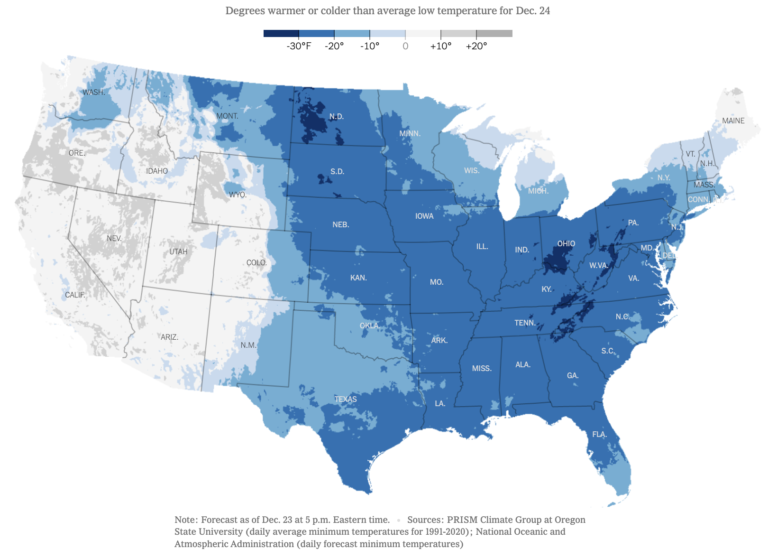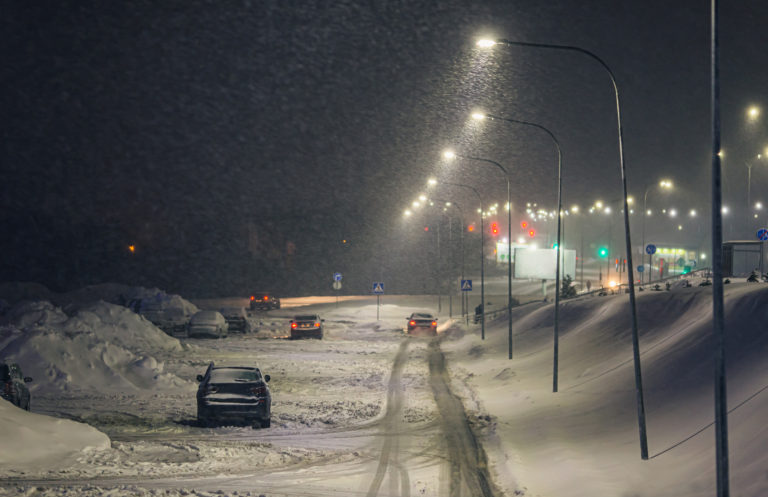U.S.: Cash and the “Blizzard of ‘22”
In mid-December, a massive winter storm brought heavy snow and cold winds across much of the United States. The arctic freeze stretched from the Great Lakes to the Rio Grande, lowering temperatures drastically (see Figure 1).
Roughly two-thirds of the U.S. population (more than 200 million people) faced winter weather warnings or advisories on Friday, December 23. The “bomb cyclone” caused dozens of deaths, power outages, flight cancellations, and dangerous driving conditions across the country.
Figure 1. United States: Degrees Warmer or Colder than Average Low Temperature for December 24, 2024 (Fahrenheit Degrees)

Note: -30 ºF = -34.44 ºC; +20 ºF = -6.7 ºC. Source: New York Times.
Power Outages
The winter storm caused electricity outages from Maine to Seattle. By Friday morning, 1.14 million U.S. and 155,000 customers in Canada had no power.
Power outages took digital paymentA transfer of funds which discharges an obligation on the part of a payer vis-à-vis a payee. More infrastructures offline like other extreme weather events. Their effects were limited, as the blizzard stranded all but essential workers at home and kept shoppers eager to get holiday gifts away from stores.
Flights Disrupted
Airlines canceled thousands of flights, stranding travelers. U.S. airlines are obligated to provide a full refund for a canceled flight.
- “If you decide not to take a trip, try to push for getting a cashMoney in physical form such as banknotes and coins. More refund rather than a voucher. This may sound very obvious, but cash is a lot more valuable than an airline voucher,” says Scott Keyes, founder of Scott’s Cheap Flights, an airfare deals service.
- In August 2022, the U.S. Department of Transportation (DoT) announced a pending rule to strengthen protections for consumers seeking refunds involving airline tickets purchased with cash or checks.
Buffalo: Eye of the Storm
“Historic storms are no longer historic to us.” – New York Governor Kathy Hochul.
In western New York state (a region well prepared for winter conditions) and Buffalo (the state’s second-most populous city), the worst blizzard since 1977 left at least 39 dead and thousands without power. Hurricane-force winds reached 74 mph (119 km/h), paralyzing emergency response efforts.
Payments during the Blizzard
Mobile payments: Some users requested donations via the Cash app. However, most people’s cell phones ran out of battery, such as Jeremy Manahan, who waited 29 hours without electricity until he could charge his phone. Cellphone batteries’ perform less optimally below 0 ºC and stop working at -15 ºC.
- “Stuck in Buffalo. Can’t leave the hotel. Eating breakfast for four days. Really could use some funds so I don’t have to leave [car] here. It’s $2000 fine if you get caught driving. #WinterStorm2022 $DKMadre cash app – Rebecca Powell (@DKCSCMadre)
- “$danielleleigh21 cash app. Please help. I l[i]ve in buffalo my apartment building has no electric[ity] it’s literally-14[ºF]” – Danielle Ray (@Okay_Danielle).
Card payments. Lacking employees, some gas stations only accepted card payments. “Thruway update: Fuel services at Angola Service Area (south of Buffalo on I-90) are limited to credit card sales only. The Thruway Authority says this is due to weather and no staffing. Restaurants and restrooms are open.” – Robert Harding (@RobertHarding).
Getting cash in advance: Nerdwallet writer Taryn Phaneuf recommended “having extra cash available [as that] could ease the stress of needing to replace food or stay in a hotel if the power in your home goes out for a long time before the storm.”
Cash came in handy: Stuck in her car, Cassandra Garmon, a single mother and pharmacy technician, wrote a message to the Buffalo Blizzard 2022 Facebook group: “I’m in desperate need of help y’all. I’ve been out here since 3pm please. On Clinton between Babcock and Bushnell. I have cash.” Eventually, a volunteer helped Garmon with a snowmobile; others brought her home to her two daughters.
Cash kept small businesses going: Craig Elston, owner of C&C Cutz in Buffalo, helped dozens of people find shelter in his barbershop during the blizzard. Elston also gave haircuts to “maybe five people […]. If you’re going to be buying food for 30 people who are sleeping in your barbershop, you can at least earn some cash through cutting people’s hair.”
After the Blizzard: Retailers and the Cash Infrastructure
Buffalo residents were running low on food, medicine, and other essentials. Many supermarkets, grocery stores, and restaurants remained closed through Tuesday, December 27. Some looters stole cash registers and an A.T.M. at Broadway Market.
On December 27, the N.Y.S. Department of Financial Services asked banks to give free banking and cash services to western New Yorkers to limit the need for travel.
- Relief measures include “waiving A.T.M. fees, allowing New Yorkers to use the nearest A.T.M. available to them without a penalty; increasing A.T.M. daily cash withdrawal limits; and easing restrictions on cashing non-customer checks,” said Adrienne A. Harris, the department’s superintendent. Recently, Harris proposed guidance for banks’ management of climate changeThis is the action by which certain banknotes and/or coins are exchanged for the same amount in banknotes/coins of a different face value, or unit value. See Exchange. More risks.
- “As we await the end of this storm, this new guidance will ensure that New Yorkers can safely access financial services without traveling in these dangerous conditions,” said Governor Kathy Hochul.
Cash and Emergency Preparedness 
The resilience of cash in natural disasters (such as snowstorm Uri in Texas and hurricane Ida in Louisiana) makes it essential to the public and private sectors’ preparedness, emergency, and recovery efforts.
- The Government of Canada recommends having “cash, traveller’s cheques and change” in basic emergency kits. The U.S. Department of Homeland Security (D.H.S.) recommends keeping “cash or traveler’s checks” as emergency supplies. New York State urges citizens to keep “cash and coins” in their emergency supply kit. New York City advises residents to have “cash, in small bills” in their Go Bag for emergencies.
- Waffle House, a U.S. restaurant chain with 1,900 locations, is open 24 hours a day, 365 days a year. Its contingency plansWork performed for the purpose of establishing protocols and procedures to be followed for the occurrence of an incident (theft, fire, natural catastrophe, etc.) or a situation (strike, unexpected demand, etc.), where normal work systems are unable to resolve problems. More include allowing customers to pay in cash when power outages shut down cash registers and point-of-sale (P.O.S.) terminals. The U.S. Federal Emergency Management Agency (FEMA) uses the “Waffle House Index” to assess storms’ severity, given the chain’s preparedness.